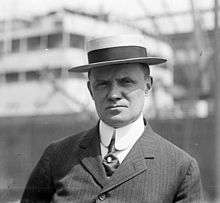Charles Seymour Whitman
| Charles Seymour Whitman | |
|---|---|
 Whitman in 1910 | |
| 41st Governor of New York | |
|
In office January 1, 1915 – December 31, 1918 | |
| Lieutenant | Edward Schoeneck |
| Preceded by | Martin H. Glynn |
| Succeeded by | Alfred E. Smith |
| New York County District Attorney | |
|
In office 1910–1913 | |
| Preceded by | William Travers Jerome |
| Succeeded by | Charles A. Perkins |
| Personal details | |
| Born |
Charles Seymour Whitman September 29, 1868 Hanover, Connecticut, United States |
| Died |
March 29, 1947 (aged 78) Manhattan, New York City, New York, United States |
| Political party | Republican |
| Spouse(s) |
Thelma Somerville Cudlipp (m. 1933; his death 1947) |
| Relations | John Russell Whitman (grandson) |
| Parents |
John Seymour Whitman Olivia Arne |
| Education |
Amherst College (B.A.) New York University School of Law (LL.B.) |
Charles Seymour Whitman (September 29, 1868 – March 29, 1947) served as the 41st Governor of New York from January 1, 1915 to December 31, 1918. He was also a delegate to Republican National Convention from New York in 1916.
Early life
Whitman was born on September 29, 1868 in Hanover, Connecticut. He was the son of John Seymour Whitman (1833–1909) and Olivia Arne (1831–1904).
He graduated from Amherst College in 1890. He graduated from New York University School of Law in 1894; he was admitted to the bar later that yar, and practiced in New York City.[1]
Career
In 1901, he was appointed assistant corporation counsel of New York County, New York where his effective work won for him the post of city magistrate. In this capacity, he founded the Night Court for the immediate trial of all offenders arrested at night. In 1907, Governor Charles Evans Hughes appointed him a judge of the Court of Sessions, and in the following year deputy attorney general in the investigation of election frauds in northern New York.
New York County District Attorney
In 1909, he was elected New York County District Attorney on a Fusion ticket. In this capacity, he secured representation of the District Attorney's staff in the city magistrate's office, and was active in suppressing arson offenders.[1]
As District Attorney, he gained national fame in prosecuting New York City Police Lt. Charles Becker for the July 16, 1912, murder of Times Square gambling house operator Herman Rosenthal in front of West 43rd Street's Hotel Metropole, owned by Lower East Side Tammany Hall leader "Big Tim" Sullivan. Whitman's handling of the case was most effective in unearthing and reforming the relations between certain members of the New York City police and professional criminals.[1] Later, as governor, Whitman signed Becker's death warrant and presided over his electrocution. Whitman was a member of the Union League Club of New York and, fearing he was under surveillance, used the clubhouse to secretly interview witnesses during the Becker case.
The handling of the Schmidt murder case, the prosecution of the poultry trust and of election frauds won for Whitman high commendation. He was renominated for District Attorney in 1913 and elected almost unanimously.[1]
Governor of New York
He served as the 41st Governor of New York from January 1915[2] to December 1918. His principal plank was the reformation of the state finances, which he proceeded to institute vigorously by a reorganization of state departments and a thorough investigation of the salaries of civil service employees.[1]
In 1915, he became a member of the Empire State Society of the Sons of the American Revolution.
In 1916, Whitman won re-election as governor against reform Democratic Judge Samuel Seabury. After his election, he sent to every enrolled voter a report of his first term as governor, containing also reports of the heads of other state departments. He also inaugurated a state constabulary, and after entrance of the United States into World War I he inaugurated a new state guard to replace the National Guard on service in France. In 1916, he was also elected chairman of the Republican National Convention, where he urged the nomination of former New York Governor Hughes for President of the United States.[1] In 1917, he commissioned the creation of the New York State Police and selected George Fletcher Chandler to organize and head the force.[3]
In 1918, he was defeated for re-election by Tammany Hall Democrat Alfred E. Smith (then President of the New York City Board of Aldermen).
Personal life
in 1908, Whitman was married to Olive Hitchcock (1880–1928).[4][5] Together, they were the parents of:
- Olive Whitman[6]
- Charles S. Whitman, Jr, (1915–2002), who was a New York Judge.
After the death of his first wife in 1928, in 1933 he married Thelma Somerville (née Cudlipp) Grosvenor (1891–1983), the widow of Edwin Prescott Grosvenor, himself the son of Edwin A. Grosvenor (1845–1936) and brother of Gilbert Hovey Grosvenor.[7][6][8]
He died on March 29, 1947 in Manhattan, New York City.[9][6]
Legacy
His portrait was painted in 1921 by the Swiss-born American portrait painter Adolfo Müller-Ury (1862–1947) and is the property of the New York State Capitol at Albany; Müller-Ury had previously painted a portrait of his baby daughter, Olive (the future Mrs Parsons), which was much admired when exhibited, and was given by her to the Preservation Society of Newport County, Rhode Island, where it now hangs at Green Animals.
Descendants
His grandson, former First Gentleman of New Jersey John Russell Whitman (1944–2015), married Christine Todd (b. 1946), who served as a Republican Governor of New Jersey and Administrator of the Environmental Protection Agency.
See also
Further reading
- Robert Slayton's biography, Empire Statesman: the Rise and Redemption of Al Smith, discusses Whitman's governorship and campaigns for the office against Smith.[10]
- Whitman is a character in E.L. Doctorow's historical novel Ragtime (although he does not figure significantly in the later film based on the novel).
References
- 1 2 3 4 5 6

- ↑ "The first Republican Governor of New York since Hughes". The Independent. November 16, 1914. Retrieved July 24, 2012.
- ↑ "NYSP History: 1917 to 1929 The Formative Years". www.troopers.ny.gov. New York State Police. Retrieved 19 April 2017.
- ↑ "Ex-Judge Whitman Weds. His Marriage To Miss Hitchcock Takes Place At Church Of The Ascension". The New York Times. December 23, 1908.
- ↑ "Mrs. C. S. Whitman Dies Of Pneumonia. Ex-Governor's Wife Long Active in Political, Social and Charitable Causes". The New York Times. May 30, 1926.
- 1 2 3 "Ex-Gov. Whitman Dies Here At 78. Executive of State, 1915-18, 'Broke' Rosenthal Case as District Attorney in 1912 78". The New York Times. 30 March 1947. Retrieved 30 September 2017.
- ↑ "Ex-Gov. Whitman Engaged To Marry. Betrothal To Mrs. Thelma S. C. Grosvenor, Widow Of Lawyer, Is Announced. Fiance Formerly Judge Served As District Attorney Of New York County His Daughter To Be Wed In June". The New York Times. April 5, 1933.
- ↑ "Ex-Gov. Whitman Married Quietly. Mrs. E. P. Grosvenor Becomes His Bride As Two Families Witness Ceremony. Neither Has Attendants. Rev. Dr. J. V. Moldenhawer Officiates. Bridegroom's Daughter To Be Married On June 5". The New York Times. April 7, 1933.
- ↑ "Death Takes Ex-Governor Of New York. Charles S. Whitman, Hanover, Conn., Native Was Elected in 1914". Associated Press in The Hartford Courant. March 30, 1947. Retrieved March 22, 2010.
Charles S. Whitman, 78, former governor of New York, died tonight.
- ↑ Robert A. Slayton, Empire Statesman: The Rise and Redemption of Al Smith (New York, 2001: The Free Press; ISBN 978-0-684-86302-3), especially pages 116 to 121.
External links
| Wikisource has the text of a 1921 Collier's Encyclopedia article about Charles S. Whitman. |

- People v. Seidenshner 210 NY 341
- People v. Becker 210 NY 274
- People v. Becker 215 NY 126
| Legal offices | ||
|---|---|---|
| Preceded by William Travers Jerome |
New York County District Attorney 1910–1913 |
Succeeded by Charles A. Perkins |
| Political offices | ||
| Preceded by Martin H. Glynn |
Governor of New York 1915–1918 |
Succeeded by Al Smith |
| Party political offices | ||
| Preceded by Job E. Hedges |
Republican Nominee for Governor of New York 1914, 1916, 1918 |
Succeeded by Nathan L. Miller |
